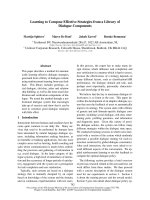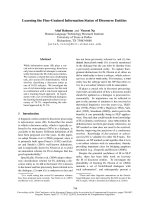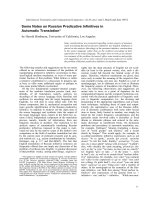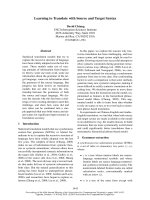Báo cáo khoa học: "Learning to Temporally Order Medical Events in Clinical Text" ppt
Bạn đang xem bản rút gọn của tài liệu. Xem và tải ngay bản đầy đủ của tài liệu tại đây (297.56 KB, 5 trang )
Proceedings of the 50th Annual Meeting of the Association for Computational Linguistics, pages 70–74,
Jeju, Republic of Korea, 8-14 July 2012.
c
2012 Association for Computational Linguistics
Learning to Temporally Order Medical Events in Clinical Text
Preethi Raghavan
∗
, Eric Fosler-Lussier
∗
, and Albert M. Lai
†
∗
Department of Computer Science and Engineering
†
Department of Biomedical Informatics
The Ohio State University, Columbus, Ohio, USA
{raghavap, fosler}@cse.ohio-state.edu,
Abstract
We investigate the problem of ordering med-
ical events in unstructured clinical narratives
by learning to rank them based on their time
of occurrence. We represent each medical
event as a time duration, with a correspond-
ing start and stop, and learn to rank the
starts/stops based on their proximity to the ad-
mission date. Such a representation allows us
to learn all of Allen’s temporal relations be-
tween medical events. Interestingly, we ob-
serve that this methodology performs better
than a classification-based approach for this
domain, but worse on the relationships found
in the Timebank corpus. This finding has im-
portant implications for styles of data repre-
sentation and resources used for temporal re-
lation learning: clinical narratives may have
different language attributes corresponding to
temporal ordering relative to Timebank, im-
plying that the field may need to look at a
wider range of domains to fully understand the
nature of temporal ordering.
1 Introduction
There has been considerable research on learning
temporal relations between events in natural lan-
guage. Most learning problems try to classify event
pairs as related by one of Allen’s temporal rela-
tions (Allen, 1981) i.e., before, simultaneous, in-
cludes/during, overlaps, begins/starts, ends/finishes
and their inverses (Mani et al., 2006). The Timebank
corpus, widely used for temporal relation learning,
consists of newswire text annotated for events, tem-
poral expressions, and temporal relations between
events using TimeML (Pustejovsky et al., 2003). In
Timebank, the notion of an “event” primarily con-
sists of verbs or phrases that denote change in state.
However, there may be a need to rethink how we
learn temporal relations between events in different
domains. Timebank, its features, and established
learning techniques like classification, may not work
optimally in many real-world problems where tem-
poral relation learning is of great importance.
We study the problem of learning temporal rela-
tions between medical events in clinical text. The
idea of a medical “event” in clinical text is very dif-
ferent from events in Timebank. Medical events
are temporally-associated concepts in clinical text
that describe a medical condition affecting the pa-
tient’s health, or procedures performed on a patient.
Learning to temporally order events in clinical text
is fundamental to understanding patient narratives
and key to applications such as longitudinal studies,
question answering, document summarization and
information retrieval with temporal constraints. We
propose learning temporal relations between medi-
cal events found in clinical narratives by learning to
rank them. This is achieved by representing medical
events as time durations with starts and stops and
ranking them based on their proximity to the admis-
sion date.
1
This implicitly allows us to learn all of
Allen’s temporal relations between medical events.
In this paper, we establish the need to rethink
the methods and resources used in temporal re-
lation learning, as we demonstrate that the re-
sources widely used for learning temporal relations
in newswire text do not work on clinical text. When
we model the temporal ordering problem in clinical
text as a ranking problem, we empirically show that
it outperforms classification; we perform similar ex-
periments with Timebank and observe the opposite
conclusion (classification outperforms ranking).
1
The admission date is the only explicit date always present
in each clinical narrative.
70
e1 before e2 e1 equals e2
e1.start e1.start; e2.start
e1.stop e1.stop; e2.stop
e2.start
e2.stop
e1 overlaps with e2 e1 starts e2
e1.start e1.start; e2.start
e2.start e1.stop
e1.stop e2.stop
e2.stop
e2 during e1 e2 finishes e1
e1.start e1.start
e2.start e2.start
e2.stop e1.stop; e2.stop
e1.stop
Table 1: Allen’s temporal relations between medical
events can be realized by ordering the starts and stops
2 Related Work
The Timebank corpus provides hand-tagged fea-
tures, including tense, aspect, modality, polarity and
event class. There have been significant efforts
in machine learning of temporal relations between
events using these features and a wide range of other
features extracted from the Timebank corpus (Mani
et al., 2006; Chambers et al., 2007; Lapata and Las-
carides, 2011). The SemEval/TempEval (Verhagen
et al., 2009) challenges have often focused on tem-
poral relation learning between different types of
events from Timebank. Zhou and Hripcsak (2007)
provide a comprehensive survey of temporal reason-
ing with clinical data. There has also been some
work in generating annotated corpora of clinical text
for temporal relation learning (Roberts et al., 2008;
Savova et al., 2009). However, none of these cor-
pora are freely available. Zhou et al. (2006) propose
a Temporal Constraint Structure (TCS) for medical
events in discharge summaries. They use rule-based
methods to induce this structure.
We demonstrate the need to rethink resources,
features and methods of learning temporal relations
between events in different domains with the help of
experiments in learning temporal relations in clini-
cal text. Specifically, we observe that we get better
results in learning to rank chains of medical events
to derive temporal relations (and their inverses) than
learning a classifier for the same task.
The problem of learning to rank from examples
has gained significant interest in the machine learn-
ing community, with important similarities and dif-
ferences with the problems of regression and clas-
sification (Joachims et al., 2007). The joint cumu-
lative distribution of many variables arises in prob-
HISTORY PHYSICAL DATE: 09/01/2007
NAME: Smith Daniel T MR#: XXX-XX-XXXX
ATTENDING PHYSICIAN: John Payne MD DOB: 03/10/1940
HISTORY OF PRESENT ILLNESS
The patient is a 67-year-old Caucasian male with a history of paresis secondary to back
injury who is bedridden status post colostomy and PEG tube who was brought by EMS with
a history of fever. The patient gives a history of fever on and off associated with chills for
the last 1 month. He does give a history of decubitus ulcer on the back but his main
complaint is fever associated with epigastric discomfort.
PAST MEDICAL HISTORY
Significant for polymicrobial infection in the blood as well as in the urine in July 2007 history
of back injury with paraparesis. He is status post PEG tube and colostomy tube.
REVIEW OF SYSTEMS
Positive for decubitus ulcer. No cough. There is fever. No shortness of breath.
PHYSICAL EXAMINATION
On physical exam the patient is a debilitated malnourished gentleman in mild distress.
Abdomen showed PEG tube with discharging pus and there are multiple scars one in the
midline. It had a healing wound. Bowel sounds were present. Extremities revealed pain and
atrophied muscles in the lower extremities with decubitus ulcer which had a transparent
bandage in the decubitus area which was stage 2-3. CNS - The patient is alert and awake x3.
There was good power in both upper extremities. Cranial nerves II-XII grossly intact.
Figure 1: Excerpt from a sanitized clinical narrative (history &
physical report) with medical events underlined.
lems of learning to rank objects in information re-
trieval and various other domains. To the best of our
understanding, there have been no previous attempts
to learn temporal relations between events using a
ranking approach.
3 Representation of Medical Events (MEs)
Clinical narratives contain unstructured text describ-
ing various MEs including conditions, diagnoses
and tests in the history of a patient, along with
some information on when they occurred. Much of
the temporal information in clinical text is implicit
and embedded in relative temporal relations between
MEs. A sample excerpt from a note is shown in
Figure 1. MEs are temporally related both qualita-
tively (e.g., paresis before colostomy) and quantita-
tively (e.g. chills 1 month before admission). Rela-
tive time may be more prevalent than absolute time
(e.g., last 1 month, post colostomy rather than on
July 2007). Temporal expressions may also be fuzzy
where history may refer to an event 1 year ago or 3
months ago. The relationship between MEs and time
is complicated. MEs could be recurring or continu-
ous vs. discrete date or time, such as fever vs. blood
in urine. Some are long lasting vs. short-lived, such
as cancer, leukemia vs. palpitations.
We represent MEs of any type of in terms of their
time duration. The idea of time duration based rep-
resentation for MEs is in the same spirit as TCS
(Zhou et al., 2006). We break every ME me into
me.start and me.stop. Given the ranking of all starts
and stops, we can now compose every one of Allen’s
temporal relations (Allen, 1981). If it is clear from
context that only the start or stop of a ME can be de-
termined, then only that is considered. For instance,
“history of paresis secondary to back injury who is
bedridden status post colostomy” indicates the start
of paresis is in the past history of the patient prior
71
to colostomy. We only know about paresis.start rel-
ative to other MEs and may not be able determine
paresis.stop. For recurring and continuous events
like chills and fever, if the time period of recurrence
is continuous (last 1 month), we consider it to be
the time duration of the event. If not continuous, we
consider separate instances of the ME. For MEs that
are associated with a fixed date or time, the start and
stop are assumed to be the same (e.g., polymicrobial
infection in the blood as well as in the urine in July
2007). In case of negated events like no cough, we
consider cough as the ME with a negative polarity.
Its start and stop time are assumed to be the same.
Polarity allows us to identify events that actually oc-
curred in the patient’s history.
4 Ranking Model and Experiments
Given a patient with multiple clinical narratives, our
objective is to induce a partial temporal ordering of
all medical events in each clinical narrative based on
their proximity to a reference date (admission).
The training data consists of medical event (ME)
chains, where each chain consists of an instance of
the start or stop of a ME belonging to the same clin-
ical narrative along with a rank. The assumption is
that the MEs in the same narrative are more or less
semantically related by virtue of narrative discourse
structure and are hence considered part of the same
ME chain. The rank assigned to an instance indi-
cates the temporal order of the event instance in the
chain. Multiple MEs could occupy the same rank.
Based on the rank of the starts and stops of event
instances relative to other event instances, the tem-
poral relations between them can be derived as indi-
cated in Table 1. Our corpus for ranking consisted
of 47 clinical narratives obtained from the medical
center and annotated with MEs, temporal expres-
sions, relations and event chains. The annotation
agreement across our team of annotators is high; all
annotators agreed on 89.5% of the events and our
overall inter-annotator Cohen’s kappa statistic (Con-
ger, 1980) for MEs was 0.865. Thus, we extracted
47 ME chains across 4 patients. The distribution of
MEs across event chains and chains across patients
(p) is as as follows. p1 had 5 chains with 68 MEs,
p2 had 9 chains with 90 MEs, p3 had 20 chains with
119 MEs and p4 had 13 chains with 82 MEs. The
distribution of chains across different types of clin-
ical narratives is shown in Figure 2. We construct
a vector of features, from the manually annotated
corpus, for each medical event instance. Although
0
2
4
6
8
10
12
14
Radiology
Discharge Summaries
Pathology
History & Physical
p1
p2
p3
p4
Figure 2: Distribution of the 47 medical event chains derived
from discharge summaries, history and physical reports, pathol-
ogy and radiology notes across the 4 patients.
there is no real query in our set up, the admission
date for each chain can be thought of as the query
“date” and the MEs are ordered based on how close
or far they are from each other and the admission
date. The features extracted for each ME include
the the type of clinical narrative, section informa-
tion, ME polarity, position of the medical concept
in the narrative and verb pattern. We extract tempo-
ral expressions linked to the ME like history, before
admission, past, during examination, on discharge,
after discharge, on admission. Temporal references
to specific times like next day, previously are re-
solved and included in the feature set. We also ex-
tract features from each temporal expression indicat-
ing its closeness to the admission date. Differences
between each explicit date in the narrative is also
extracted. The UMLS(Bodenreider, 2004) semantic
category of each medical concept is also included
based on the intuition that MEs of a certain semantic
group may occur closer to admission. We tried using
features like the tense of ME or the verb preceding
the ME (if any), POS tag in ranking. We found no
improvement in accuracy upon their inclusion.
In addition to the above features, we also anchor
each ME to a coarse time-bin and use that as a fea-
ture in ranking. We define the following sequence
of time-bins centered around admission, {way be-
fore admission, before admission, on admission, af-
ter admission, after discharge}. The time-bins are
learned using a linear-chain CRF,
2
where the obser-
vation sequence is MEs in the order in which they
appear in a clinical narrative, and the state sequence
is the corresponding label sequence of time-bins.
We ran ranking experiments using SVM-rank
(Joachims, 2006), and based on the ranking score
assigned to each start/stop instance, we derive the
relative temporal order of MEs in a chain.
3
This in
turn allows us to infer temporal relations between
2
/>3
In evaluating simultaneous, ±0.05 difference in ranking
score of starts/stops of MEs is counted as a match.
72
Relation Clinical Text Timebank
Ranking Classifier Ranking Classifier
begins 81.21 73.34 52.63 58.82
ends 76.33 69.85 61.32 82.87
simulatenous 85.45 71.31 50.23 56.58
includes 83.67 74.20 59.56 60.65
before 88.3 77.14 61.34 70.38
Table 2: Per-class accuracy (%) for ranking, classification on
clinical text and Timebank. We merge class ibefore into before.
all MEs in a chain. The ranking error on the test set
is 28.2%. On introducing the time-bin feature, the
ranking error drops to 16.8%. The overall accuracy
of ranking MEs on including the time-bin feature
is 82.16%. Each learned relation is now compared
with the pairwise classification of temporal relations
between MEs. We train a SVM classifier (Joachims,
1999) with an RBF kernel for pairwise classification
of temporal relations. The average classification ac-
curacy for clinical text using the same feature set is
71.33%. We used Timebank (v1.1) for evaluation,
186 newswire documents with 3345 event pairs. We
traverse transitive relations between events in Time-
bank, increasing the number of event-event links
to 6750 and create chains of related events to be
ranked. Classification works better on Timebank, re-
sulting in an overall accuracy of 63.88%, but rank-
ing gives only 55.41% accuracy. All classification
and ranking results from 10-fold cross validation are
presented in Table 2.
5 Discussion
In ranking, the objective of learning is formalized
as minimizing the fraction of swapped pairs over all
rankings. This model is well suited to the features
that are available in clinical text. The assumption
that all MEs in a clinical narrative are temporally re-
lated allows us to totally order events within each
narrative. This works because a clinical narrative
usually has a single protagonist, the patient. This as-
sumption, along with the availability of a fixed refer-
ence date in each narrative, allows us to effectively
extract features that work in ranking MEs. How-
ever, this assumption does not hold in newswire text:
there tend to be multiple protagonists, and it may be
possible to totally order only events that are linked to
the same protagonist. Ranking implicitly allows us
to learn the transitive relations between MEs in the
chain. Ranking ME starts/ stops captures relations
like includes and begins much better than classifi-
cation, primarily because of the date difference and
time-bin difference features. However, the hand-
tagged features available in Timebank are not suited
for this kind of model. The features work well with
classification but are not sufficiently informative to
learn time durations using our proposed event repre-
sentation in a ranking model. Features like “tense”
that are used for temporal relation learning in Time-
bank are not very useful in ME ordering. Tense
is a temporal linguistic quality expressing the time
at, or during which a state or action denoted by a
verb occurs. In most cases, MEs are not verbs (e.g.,
colostomy). Even if we consider verbs co-occurring
with MEs, they are not always accurately reflective
of the MEs’ temporal nature. Moreover, in discharge
summaries, almost all MEs or co-occurring verbs
are in the past tense (before the discharge date). This
is complicated by the fact that the reference time/
ME with respect to which the tense of the verb is
expressed is not always clear. Based on the type of
clinical narrative, when it was generated, the refer-
ence date for the tense of the verb could be in the
patient’s history, admission, discharge, or an inter-
mediate date between admission and discharge. For
similar reasons, features like POS and aspect are not
very informative in ordering MEs. Moreover, fea-
tures like aspect require annotators with not only a
clinical background but also some expert knowledge
in linguistics, which is not feasible.
6 Conclusions
Representing and reasoning with temporal informa-
tion in unstructured text is crucial to the field of natu-
ral language processing and biomedical informatics.
We presented a study on learning to rank medical
events. Temporally ordering medical events allows
us to induce a partial order of medical events over
the patient’s history. We noted many differences be-
tween learning temporal relations in clinical text and
Timebank. The ranking experiments on clinical text
yield better performance than classification, whereas
the performance is the exact opposite in Timebank.
Based on experiments in two very different domains,
we demonstrate the need to rethink the resources and
methods for temporal relation learning.
Acknowledgments
The project was supported by the NCRR,
Grant UL1RR025755, KL2RR025754, and
TL1RR025753, is now at the NCATS, Grant
8KL2TR000112-05, 8UL1TR000090-05,
8TL1TR000091-05. The content is solely the
responsibility of the authors and does not necessar-
ily represent the official views of the NIH.
73
References
James F. Allen. 1981. An interval-based representation
of temporal knowledge. In IJCAI, pages 221–226.
Olivier Bodenreider. 2004. The unified medical lan-
guage system (umls): integrating biomedical termi-
nology. Nucleic Acids Research, 32(suppl 1):D267–
D270.
Nathanael Chambers, Shan Wang, and Daniel Jurafsky.
2007. Classifying temporal relations between events.
In ACL.
A.J. Conger. 1980. Integration and generalization of
kappas for multiple raters. In Psychological Bulletin
Vol 88(2), pages 322–328.
Thorsten Joachims, Hang Li, Tie-Yan Liu, and ChengX-
iang Zhai. 2007. Learning to rank for information
retrieval (lr4ir 2007). SIGIR Forum, 41(2):58–62.
Thorsten Joachims. 1999. Making large-scale SVM
learning practical. In Bernhard Sch
¨
olkopf, Christo-
pher John C. Burges, and Alexander J. Smola, editors,
Advances in Kernel Methods - Support Vector Learn-
ing, pages 169–184. MIT Press.
Thorsten Joachims. 2006. Training linear SVMs in linear
time. In KDD, pages 217–226.
Mirella Lapata and Alex Lascarides. 2011. Learn-
ing sentence-internal temporal relations. CoRR,
abs/1110.1394.
Inderjeet Mani, Marc Verhagen, Ben Wellner, Chong Min
Lee, and James Pustejovsky. 2006. Machine learning
of temporal relations. In ACL.
James Pustejovsky, Jos M. Castao, Robert Ingria, Roser
Sauri, Robert J. Gaizauskas, Andrea Setzer, Graham
Katz, and Dragomir R. Radev. 2003. TimeML: Ro-
bust specification of event and temporal expressions
in text. In New Directions in Question Answering’03,
pages 28–34.
A. Roberts, R. Gaizauskas, M. Hepple, G. Demetriou,
Y. Guo, and A. Setzer. 2008. Semantic Annotation of
Clinical Text: The CLEF Corpus. In Proceedings of
the LREC 2008 Workshop on Building and Evaluating
Resources for Biomedical Text Mining, pages 19–26.
Guergana K. Savova, Steven Bethard, Will Styler, James
Martin, Martha Palmer, James Masanz, and Wayne
Ward. 2009. Towards temporal relation discovery
from the clinical narrative. AMIA.
Marc Verhagen, Robert J. Gaizauskas, Frank Schilder,
Mark Hepple, Jessica Moszkowicz, and James Puste-
jovsky. 2009. The tempeval challenge: identifying
temporal relations in text. Language Resources and
Evaluation, 43(2):161–179.
Li Zhou and George Hripcsak. 2007. Temporal rea-
soning with medical data - a review with emphasis
on medical natural language processing. Journal of
Biomedical Informatics, pages 183–202.
Li Zhou, Genevieve B. Melton, Simon Parsons, and
George Hripcsak. 2006. A temporal constraint struc-
ture for extracting temporal information from clinical
narrative. Journal of Biomedical Informatics, pages
424–439.
74









